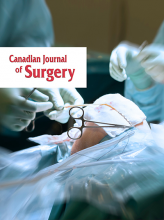Article Figures & Tables
Tables
- Table I
Demographics and Crude Complication Rates After Total Hip Replacement With and Without Previous Hip Fusion
Demographic factor Fusion No fusion Mean age, yr 58.5 66.9* Follow-up, yr 2.5 2.5 Male sex, % 60 43† Diagnosis not osteoarthritis, % 47.5 8.9‡ Comorbid conditions > 1, % 0 2.7 Mean hospital volume, no./yr 181 136† Mean surgeon volume, no./yr 76 60† Mean length of hospital stay, d 10.3 10.3 Complication present at index admission, % 45 10.9‡ Revision within 4 yr, % 10 1.8* Infection within 4 yr, % 10 1.3§ Girdlestone procedure performed within 4 yr, % 5 0.3§ Urinary tract infection at index admission, % 0 2.1 Deep venous thrombosis within 3 mo of index admission, % 0 2.2 Student’s t-test was used for continuous variables, the χ2 test for categorical variables (with continuity correction). Fisher’s exact test was used when 1 or more cells had fewer than 5 expected counts. Comparisons between patients who underwent hip fusion takedown and those who did not may be biased since no adjustment was made for other potentially confounding factors.
↵* p < 0.01,
↵† p < 0.05,
↵‡ p < 0.0001,
↵§ p < 0.001
- Table II
The Odds of Complications After Total Hip Replacement for Patients With and Without Previous Hip Fusion
Outcome Odds ratio (with:without fusion) 95% confidence interval Girdlestone resection 14.9 3.1–70.6 Infection 6.9 2.3–20.3 Complications during index admission 6 3.1–11.5 Revision 4.9 1.7–14.3 An odds ratio > 1 implies that the complication is more likely to occur after conversion of a previous hip fusion. In all cases the estimate is adjusted for age, gender, diagnosis, comorbidity, admission year, follow-up time, and surgeon and hospital volume. All odds ratios are statistically significant at p < 0.05.
- Table III
Demographics and Crude Complication Rates After Total Knee Replacement With and Without Previous Knee Fusion
Demographic factor Fusion No fusion Mean age, yr 60.9 69.6* Follow-up, yr 2.8 2.4 Male sex, % 61.1 38.0† Diagnosis not osteoarthritis, % 33.3 8.8* Comorbid conditions > 1, % 11.1 3.2§ Mean hospital volume, no./yr 106.8 143.9 Mean surgeon volume, no./yr 38.5 49.5 Mean length of hospital stay, d 13.1 10.3† Complication present at index admission, % 22.2 10.3 Revision within 4 yr, % 5.6 2.0 Fusion or re-fusion within 4 yr, % 11.1 0.1‡ Excision within 4 yr, % 16.7 0.8‡ Patellar replacement or patelloplasty. % 27.8 85.3‡ Infection within 4 yr, % 11.1 2.2 Urinary tract infection at index admission, % 5.6 2.0 Deep venous thrombosis within 3 mo of index admission, % 5.6 2.6 Student’s t-test was used for continuous variables, the χ2 test for categorical variables (with continuity correction). Fisher’s exact test was used when 1 or more cells had fewer than 5 expected counts. Comparisons between patients who underwent hip fusion takedown and those who did not may be biased since no adjustment was made for other potentially confounding factors.
↵* p < 0.01,
↵† p < 0.05,
↵‡ p < 0.0001,
↵§ p < 0.001
- Table IV
The Odds of Complications After Total Knee Replacement for Patient With and Without Previous Knee Fusion
Outcome Odds ratio (with:without fusion) 95% confidence interval Knee resection arthroplasty 15.8 4.3–58.5 Infection 4.0 0.9–17.8 Complications during index admission 2.7 0.9–8.3 Revision 1.9 0.25–14.5 Repeat fusion of the knee 82.0 15.3–44.2 An odds ratio > 1 implies that the complication is more likely to occur after conversion of a previous knee fusion. In all cases the estimate is adjusted for age, gender, diagnosis, admission year, follow-up time, and surgeon and hospital volume. A 95% confidence level that includes 1 suggests that the result was not significant at p < 0.05. Significant findings are highlighted.
Demographic factor Series Current study Reikeras et al, 1995 (31) Kilgus et al, 1990 (12) Strathy and Fitzgerald, 1988 (13) Cameron and Jung, 1987 (10) Hardinge et al 1986 (11) Lubahn et al 1980 (6) No. of joints 40 46 41 80 13 112 17 Surgically fused, % NA NA 31.7 80 100 65.2 29.4 Follow-up, yr 1–4 5–13 7 9–15 1–9 2–19 < 9 Mean age, yr 58.5 58 53 49.8 49 NA 58.5 Male, % 60 19.6 48.8 NA 53.8 NA 70.6 Infection, % 10 0 9.8 11.3 0 1.8 5.9 Excision, % 0 0 0 1.3 0 0 5.9 Revision, % 10 15.2 0 25 0 2.7 5.9 Repeat fusion, % 0 0 0 0 0 0 0 Function NA 74% needed aids after (none before), 76% good & excellent Fewer aids 45% good or excellent 69.2% good and excellent Relief of back pain and function Relief of back and ipsilateral knee pain Mean range of movement (flexion) NA NA 87° NA 88° NA 72° The information presented in the table is taken from English-language publications since 1980 reporting on at least 10 patients after conversion of a hip fusion to a total joint replacement.
Demographic factor Series Current study Naranja et al, 1996 (20) Cameron and Hu, 1996 (16) Bradley et al, 1987 (14) No. of joints 18 37 17 9 Follow-up, yr 1–4 0–20 1–10 2–6 Mean age, yr 60.9 53 59.1 55 Male, % 61.1 20 58.8 11.1 Infection, % 11.1 13.5 18 0 Excision, % 16.7 1* 0 0 Revision, % 5.6 24.3 12 11.1 Repeat fusion, % 11.1 5.4 11.8 0 Function NA 42.9% housebound 58.8% good or excellent Longer Walking tolerance Mean range of movement (flexion) NA −7°–62° 0–84° 2°–64° The information presented in the table is taken from English-language publications since 1980 reporting on at least 10 patients after conversion of a knee fusion (0° of preoperative motion) to a total joint replacement.
↵* Above knee amputation









